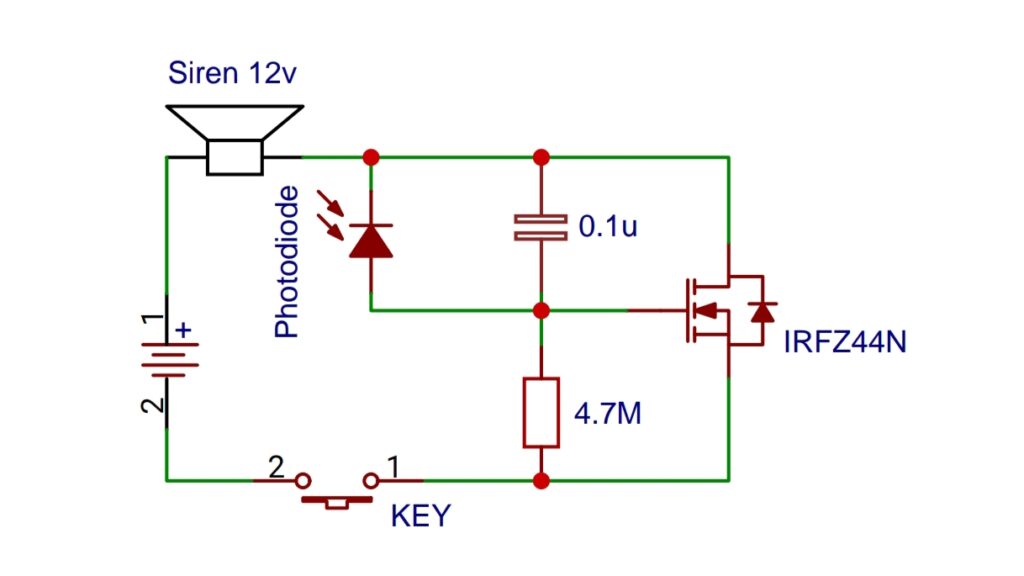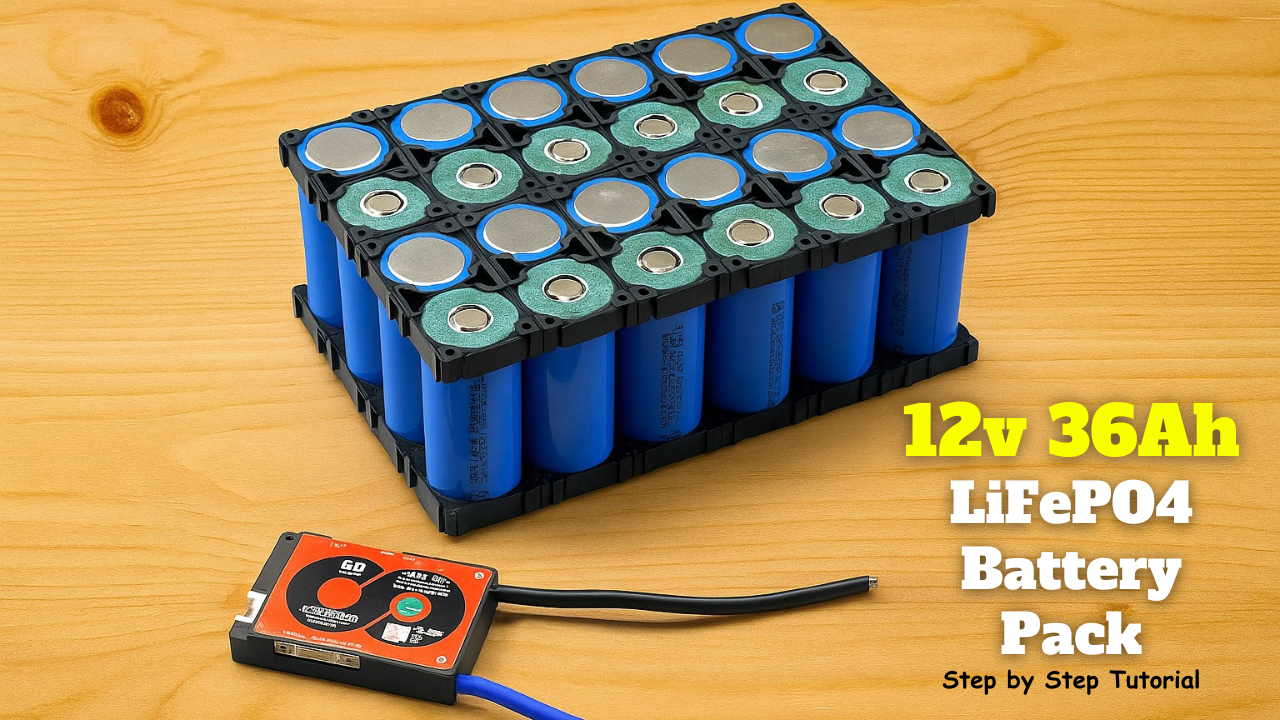Creating a fire sensor circuit using the IRFZ44N MOSFET involves using the MOSFET as a switch triggered by the detection of heat or flames. However, it’s crucial to note that detecting fire accurately and reliably requires more than just the IRFZ44N MOSFET; you’ll need additional components and sensors to detect the fire source’s heat or flames.
Components Required:
- IRFZ44N MOSFET
- Heat or flame sensor (like a thermistor, flame sensor module, or a temperature sensor)
- Resistors
- Power supply
- Alarm or indicator (buzzer, LED, etc.)
- Breadboard and jumper wires
Working Principle:
- The heat or flame sensor detects changes in temperature or the presence of flames.
- When the sensor detects a fire or significant rise in temperature, it sends a signal to the Gate of the IRFZ44N MOSFET. – The MOSFET acts as a switch. Upon receiving the signal, it allows current to flow through, activating the connected alarm or indicator, alerting about the fire detection
Circuit Diagram:

Precautions:
- Safety First: When working with fire detection circuits, ensure safety measures are in place to prevent accidents.
- Sensor Selection: The accuracy and sensitivity of the fire sensor play a crucial role in the circuit’s effectiveness.
- Power Requirements: Ensure the power supply meets the requirements of the components used in the circuit.
Remember, while the IRFZ44N can serve as a switching component, accurately detecting fires involves utilizing specialized sensors designed for fire detection. Commercially available fire sensors or modules often integrate sensors and additional circuitry for reliable fire detection, offering a more robust and trustworthy solution for fire detection applications. Always prioritize safety and accuracy when working on fire detection systems.
IRFZ44N
The IRFZ44N is a type of MOSFET (Metal-Oxide-Semiconductor Field-Effect Transistor), specifically an N-channel power MOSFET. It’s a popular choice for various electronic applications due to its capability to handle higher currents and voltages, making it suitable for power switching and amplification tasks.
Key Features:
Type: N-channel MOSFET (enhancement mode)
Voltage Rating: Typically rated for around 55 volts or higher.
Current Handling: Capable of handling significant current levels, usually in the range of tens of amperes.
Low On-Resistance: It has a low on-state resistance when fully conducting, which helps minimize power losses.
Structure and Functionality:
MOSFETs have three terminals: Gate (G), Source (S), and Drain (D). In the case of the IRFZ44N:
Gate: The gate terminal controls the flow of current between the source and drain. Applying a voltage to the gate terminal controls the conductivity of the MOSFET.
Source: This terminal is connected to the ground or common reference point.
Drain: It’s the terminal where the load or circuit is connected. The flow of current from source to drain is controlled by the gate voltage.
Working Principle:
– In its basic functionality, when a sufficient voltage is applied to the gate terminal, it creates an electric field that allows current to flow between the source and drain terminals.
– The IRFZ44N operates in enhancement mode, which means it requires a positive voltage at the gate to allow current flow between the source and drain.
Applications:
Switching Circuits: MOSFETs like the IRFZ44N are often used in power switching circuits due to their ability to handle high currents and voltages efficiently.
Motor Control: They’re employed in motor control circuits, regulating the flow of power to motors.
Power Supplies: MOSFETs contribute to regulating and controlling the flow of power in various types of power supplies.
Considerations:
Drive Voltage: It’s crucial to apply the appropriate gate voltage for the MOSFET to switch fully on or off.
Heat Dissipation: Given its capability to handle high power, proper heat sinking or thermal management might be necessary to prevent overheating.
The IRFZ44N MOSFET is a versatile and widely used component in electronic circuits requiring high-power handling and efficient switching capabilities. Its robustness and performance make it a preferred choice in various applications across industries.
Photodiode
A photodiode is a semiconductor device that generates a current or voltage when exposed to light. It’s a type of diode designed to function in the reverse bias condition, where its primary function is to convert light energy into electrical current or voltage.
Structure:
P-N Junction: Similar to regular diodes, a photodiode consists of a P-N junction. When light strikes this junction, it generates electron-hole pairs.
Construction: Photodiodes are designed to be sensitive to light, and they’re usually enclosed in a protective housing with a transparent window to allow light to enter.
How it Works:
Light Absorption: When photons (particles of light) strike the photodiode’s semiconductor material, they provide enough energy to create electron-hole pairs in the P-N junction.
Electric Field: The P-N junction in the photodiode creates an electric field. This field causes the electrons and holes created by the absorbed photons to move in opposite directions.
Current Flow: Due to the electric field, the electrons move towards the N-type region, and the holes move towards the P-type region, resulting in a flow of current.
Types:
Avalanche Photodiode (APD): This type of photodiode operates in a manner where the generated electron-hole pairs are accelerated by a high electric field, resulting in an avalanche effect and higher sensitivity.
PIN Photodiode: These photodiodes have an intrinsic (I) region placed between the P and N regions, allowing for better performance in terms of speed and sensitivity compared to standard photodiodes.
Applications:
Optical Communication: Photodiodes are used in fiber optic communication systems to convert light signals back into electrical signals.
Light Detection: They’re employed in light sensors, ambient light detection in cameras, light meters, and various light intensity measurement devices.
Barcode Scanners: Photodiodes are used in barcode scanners to detect the variations in reflected light from the barcode lines.
Characteristics:
Sensitivity: Photodiodes exhibit varying degrees of sensitivity to different wavelengths of light depending on the material they are made of.
Response Time: They generally have a fast response time, making them suitable for applications that require quick light detection.
Photodiodes offer a versatile solution for light detection and conversion in a wide range of applications, from simple light sensors to sophisticated communication systems, owing to their sensitivity, speed, and efficiency in converting light into electrical signals.
-
Safely Building a 12v 36Ah Battery Pack – Step by Step!
Building an 4S (4 series) LiFePO4 battery pack using 32140 LiFePO4 cells and a Daly Battery Management System (BMS). If you’re planning your own DIY power storage project, this guide …
-
Proximity Sensor Circuit That Actually Works!
Proximity sensors are widely used in automation, security, and robotics to detect the presence of nearby objects without physical contact. While modern sensors use complex ICs or microcontrollers, you can …
-
This Heart LED Chaser Circuit Looks Amazing!
Creating fun and eye-catching LED projects is one of the best ways to learn electronics. In this blog, we’ll walk through the process of building a heart-shaped LED chaser circuit …



